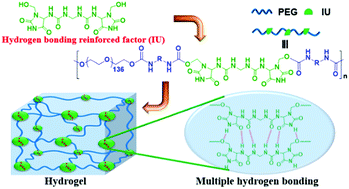Construction of supramolecular hydrogels using imidazolidinyl urea as hydrogen bonding reinforced factor†
Abstract
The development of a new hydrogen bonding reinforced factor is of importance for the design and application of supramolecular hydrogels. Herein, we use a new reinforced factor, imidazolidinyl urea (IU), for the construction of hydrogen bonding supramolecular hydrogels. Poly(ethylene glycol) (PEG), three types of diisocyanates (isophorone diisocyanate (IPDI), 4,4′-methylene bis(cyclohexyl isocyanate) (HMDI) and 4,4′-methylene bis(phenyl isocyanate) (MDI)) and IU were employed to synthesize a series of polymers through hydroxyl-isocyanate chemistry. We found that increased IU content and hydrophobicity of the diisocyanates led to a higher gel–sol transition temperature of the polymer aqueous solutions, and the formed hydrogel showed great self-healing capability in response to external mechanical forces. Moreover, we found that improved diisocyanate hydrophobicity could endow the hydrogel with promising mechanical strength, with 1.6 MPa tensile stress and 460% elongation at the break. The advanced hydrogel can also efficiently dissipate energy during deformation and can quickly recover from 200% strain at room temperature without any assistance. Since IU is commercially available and ready for polymer preparation, our work provides a simple and convenient method for the development of hydrogen bonding supramolecular hydrogels with advanced properties.



 Please wait while we load your content...
Please wait while we load your content...